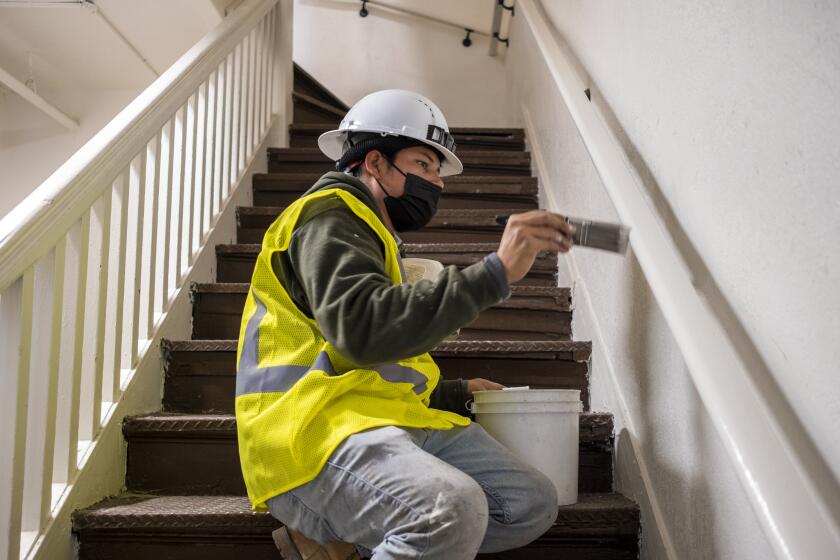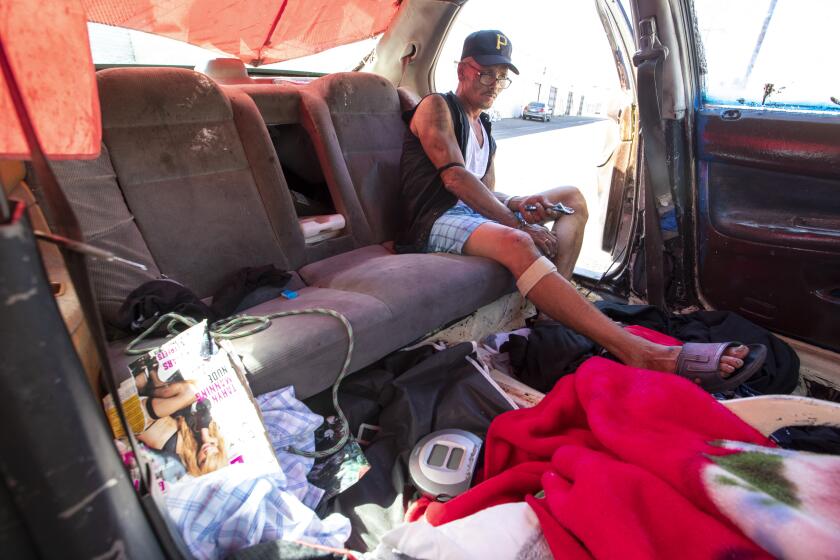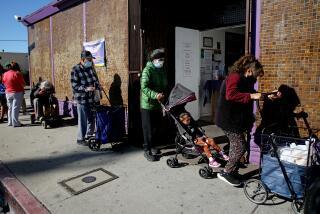Cause of homelessness? It’s not drugs or mental illness, researchers say

- Share via
SAN DIEGO — Ask just about anyone for their thoughts on what causes homelessness, and you will likely hear drug addiction, mental illness, alcoholism and poverty.
A pair of researchers, however, looked at those issues across the country and found they occur everywhere. What does vary greatly around the country, they found, was the availability of affordable housing.
In their University of California Press book “Homelessness is a Housing Problem,” authors Clayton Page Aldern and Gregg Colburn looked at various contributing issues of homelessness, including mental illness and addiction, and the per capita rate of homelessness around the country. By looking at the rate of homeless per 1,000 people, they found communities with the highest housing costs had some of the highest rates of homelessness, something that might be overlooked when looking at just the overall raw number of homeless people.
As an example, the 2019 count of people in shelters and on the street found a homeless population of 56,000 in Los Angeles County; 11,200 in King County, Wash.; 9,700 in Santa Clara County, Calif.; and 4,000 in Multnomah County, Ore. The homeless populations became similar when looking at per capita rates, with Los Angeles having six homeless people for every 1,000 residents and the other three, smaller counties having five homeless people for every 1,000.
What they had in common was a lack of affordable housing.
San Diego County had about 2.5 homeless people for every 1,000 residents, which was about the average per capita rate in the 2019 count. Aldern pointed out that the San Diego number would be greater if it included just the metropolitan area rather than the entire county.
Aldern, a data scientist and policy analyst in Seattle, and Colburn, an assistant professor of real estate at the University of Washington’s College of Built Environments, said they are not suggesting that mental illness, addictions and other issues are not contributing factors to homelessness.
“That’s certainly not the point of the book,” Colburn said. “But I firmly believe that we can’t treat our way out of this problem. You could fix all the addiction in San Diego right now and you’d still have a problem with homelessness because there just aren’t places for people to go who have lower levels of income.”
Lisa Jones, executive vice president of strategic initiatives at the San Diego Housing Commission, said she has not read the book but does see a connection between housing and homelessness.
“High-cost rental markets that far outstrip area median incomes — and push renters into paying more than 50% of their income toward rent — certainly are a significant contributing factor to making households at high risk of experiencing homelessness,” she wrote in an email.
“When households do experience homelessness, those factors make it even harder for them to exit homelessness by renting in the private rental market,” Jones continued. “We also know that the longer a household experiences homelessness, the more likely other key quality-of-life factors will be affected, such as physical and mental well-being.
A developer working to preserve affordable rentals in South L.A. and build housing for homeless people has won praise from the likes of Oprah Winfrey and Mayor Eric Garcetti, who see his work as an important step in dealing with the city’s housing crisis. But the entrepreneur’s efforts are also facing criticism from tenant advocates. A look inside SoLa Impact.
“We need to continue to strive to build a homelessness response system that has a diverse spectrum of resources to meet a household’s unique needs,” she concluded. “At the same time, we need to continue to support the efforts of policy makers at local, state and national levels to increase affordable housing development and rental assistance opportunities, streamline application processes, and reduce construction costs to increase production.”
In San Diego, nonprofits and local government agencies have made strides to create more housing. The city of San Diego purchased two extended-stay hotels in 2020 to provide homes for 400 people, and earlier this year Father Joe’s Villages open St. Teresa of Calcutta Villa to provide homes for 400 more people.
More permanent, affordable housing is planned throughout the county, but the need remains great. The city of San Diego’s Community Action Plan on Homelessness from 2019 called for significant investment in permanent solutions rather than shelters, with a recommendation to build 5,400 units, including 3,500 units of permanent supportive housing over 10 years.
The new projects would reverse a trend over the last decade that showed San Diego losing thousands of units of low-income housing, including 9,290 single-room occupancy hotels and 1,500 low-income rental units that were converted to condominiums, according to a 2016 article in the San Diego Union-Tribune.
Colburn said he was motivated to research the subject after attending meetings with political and civic leaders in Seattle and feeling they did not grasp the true cause of homelessness, which resulted in responses he called scattershot.
“One day we were talking about drugs, and one day we were talking about rent, and one day we were talking about mental health, and one day we were talking about poverty, and I thought that was counterproductive,” he said.
Colburn said it is true that people who are poor, addicted or mentally ill are more likely to experience homelessness, but a disproportionate number of people with those conditions is not the cause of higher rates of homelessness in some areas.
They have converged on Little Saigon from the rest of the state and beyond, drawn by familiar foods and the ease of communicating in their native language.
“We’re not trying to dispute that these individual vulnerabilities matter,” he said. “They certainly do. But the point is, there are people who are addicted and mentally ill in Chicago, and Chicago has one-fifth the homelessness of Seattle and San Francisco. So what’s going on here? The point is these individual vulnerabilities interact with housing markets to produce homelessness.”
The researchers looked at homelessness in West Virginia and Arkansas, which were hit hard by the opioid epidemic, and found the homeless rate was low. Housing prices in those states also are lower than in many cities with higher homeless rates, Colburn said.
Poverty also is a contributing factor of homelessness, but the researchers found areas with high poverty rates don’t necessarily have high homelessness rates if housing costs are lower. As an example, Colburn said Detroit is one of the most impoverished cities in the country, but it has one-fifth the homelessness of West Coast cities on a per capita basis.
“The point is, if you are poor, if you are addicted, if you are mentally ill in an expensive West Coast city like San Diego, you’re far more likely to experience homelessness,” he said. “And that issue explains why Seattle, Portland, San Francisco, Los Angeles and San Diego have much, much higher rates of homelessness than Miami, or Dallas, or Phoenix, for example.”
Colburn said he and Aldern studied data from the U.S. Census Bureau and the U.S. Department of Housing and Urban Development to understand population growth, incomes, rates of poverty, mobility, mental health and addictions in different areas.
“Pretty soon it became very clear that rental costs and vacancy rates were by far the biggest predictor of rates of homelessness in a community,” Colburn said. “It’s not the only factor. There are all sorts of complicated phenomenon, but it’s a far more convincing phenomenon than anything else.”
Colburn said they also attempted to dispel what they said are myths about homelessness, such as that it is higher in cities with Democratic mayors. In reality, most major cities have Democrats as mayor, but that also includes cities such as Detroit with smaller homeless populations, he said.
They also looked at the claim that homeless people move to areas with greater public assistance, something they judged by comparing the state variations in the federal Temporary Assistance for Needy Families program. They found that states that provided more dollars in the program did not have higher rates of homelessness.
The researchers also cited studies on mobility that found people with low incomes are less likely to move to another area because moving is difficult and expensive.
“The fundamental point is, if we correctly diagnosed this problem as a structural problem, which I think it is, then we need structural solutions,” Colburn said. “We need a significant commitment at all levels of government and the private sector to ensure we have an adequate supply of housing that’s affordable to people. And if we don’t do that, I’m highly, highly confident that we will not put a dent in this problem of homelessness.”
Colburn said housing must be a part of the conversation when addressing homelessness, and that conversation can be discouraging because it will take years and be a costly investment to create enough affordable housing to make a difference.
“It’s not like just flipping a light switch,” he said. “That’s why a lot of times this is a scary message to people, because it suggests we’ve got a long battle ahead of us.”
More to Read
Sign up for Essential California
The most important California stories and recommendations in your inbox every morning.
You may occasionally receive promotional content from the Los Angeles Times.
















